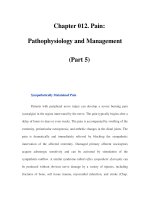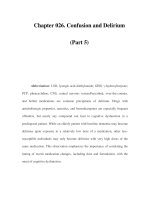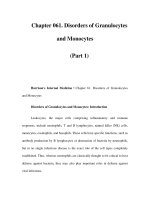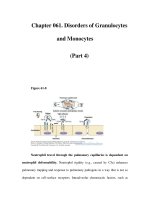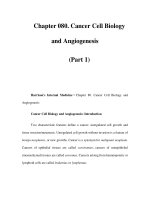Chapter 080. Cancer Cell Biology and Angiogenesis (Part 5) pps
Bạn đang xem bản rút gọn của tài liệu. Xem và tải ngay bản đầy đủ của tài liệu tại đây (59.15 KB, 7 trang )
Chapter 080. Cancer Cell Biology
and Angiogenesis
(Part 5)
Targeting BCR-ABL with Imatinib: Proof of Principle
The protein product of the Philadelphia chromosome occurs in all patients
with chronic myeloid leukemia (CML) and in ~30% of patients with adult acute
lymphoid leukemia (ALL) and encodes the fusion protein Bcr-Abl. Although the
c-Abl protooncogene is a nuclear protein whose kinase activity is tightly regulated
as a part of the DNA damage response pathway (and actually induces growth
arrest), the Bcr-Abl fusion protein is largely cytoplasmic with a constitutively
activated tyrosine kinase domain. The deregulated tyrosine kinase activity of Bcr-
Abl is required for its transforming activity. The Abl tyrosine kinase inhibitor,
imatinib mesylate (Gleevec), has validated the concept of a molecularly targeted
approach to cancer treatment.
Imatinib is a low-molecular-weight competitive inhibitor of the ATP
binding site of Bcr-Abl, c-Abl, platelet-derived growth factor receptor (PDGFR),
and c-Kit; hence it is not absolutely specific for the Bcr-Abl oncogene product
(Table 80-2). Clinical studies have demonstrated remarkable activity of this agent
in CML. In phase II studies of 532 chronic phase CML patients in whom
interferon treatment had failed, 95% obtained a hematologic complete response,
with only 9% relapse after a median follow-up of 18 months. With longer follow-
up, 75% of patients treated with imatinib in chronic phase remain in remission
after nearly 4 years. Imatinib was also active in CML blast crisis with a 52%
response rate, although the responses were short-lived (78% relapse within 1
year). Relapse during treatment with imatinib was associated with reactivation of
the tyrosine kinase either by amplification of the Bcr-Abl locus leading to
increased levels of Bcr-Abl protein or, more commonly, by point mutations within
the Bcr-Abl kinase domain that decreased imatinib binding without loss of Bcr-
Abl kinase activity. These data constitute genetic proof that the target of imatinib
is the Bcr-Abl tyrosine kinase, and that Bcr-Abl kinase activity is still required by
imatinib-resistant cells. Two drugs have been developed (dasatinib and nilotinib)
that are potent inhibitors against most imatinib resistant mutants; these compounds
have demonstrated significant activity in patients with imatinib-resistant CML.
Table 80-2 FDA-
Approved Molecularly Targeted Agents for the
Treatment of Cancer
Drug Molecular
Target
Disease
Mechanism of
Action
All-trans
retinoic acid
(ATRA)
PML-
RARα
oncogene
Acute
promyelocytic
leukemia M3
AML; t(15;17)
Inhibits
transcriptional
repression by the
PML-RARα
Imatinib
(Gleevec)
Bcr-Abl, c-
Abl, c-
Kit,
PDGFR-α/β,
Chronic
myelogenous
leukemia; GIST
Blocks ATP
binding to tyrosine
kinase active site.
Sunitinib
(Sutent)
c-Kit,
VEGFR-2,
PDGFR-β, Flt-3
GIST;
renal cell cancer
Inhibits
activated c-
Kit and
PDGFR in GIST;
inhibits VEGFR in
RCC.
Sorafinib RAF, RCC;
Targets VEGFR
(Nexavar) VEGFR-2,
PDGFR-α/β, Flt-
3,
c-Kit
may have
activity in
melanoma when
combined with
chemotherapy
pathways in RCC.
Possible activity
against BRAF in
melanoma, colon
cancer, and others.
Erlotinib
(Tarceva)
EGFR Non-
small cell lung
cancer;
pancreatic
cancer
Competitive
inhibitor of the ATP
binding site of the
EGFR.
Gefitinb
(Iressa)
EGFR Non-
small cell lung
cancer
Inhibitor of
EGFR tyrosine kinase.
Bortezomib
(Velcade)
Proteasome
Multiple
myeloma
Inhibits
proteolytic degradation
of multiple cellular
proteins.
Monoclonal Antibodies
Trastuzumab
(Herceptin)
HER2/neu
(ERBB2)
Breast
cancer
Binds HER2 on
tumor cell surface and
induces receptor
internalization.
Cetuximab
(Erbitux)
EGFR Colon
cancer,
squamous cell
carcinoma of the
head and neck
Binds
extracellular domain of
EGFR and blocks
binding of EGF and
TGF-
α; induces
receptor
internalization.
Potentiates the efficacy
chemotherapy and
radiotherapy.
Panitumomab
(Vectibix)
EGFR Colon
cancer
Like cetuximab;
likely to be very
similar in clinical
activity
Rituximab
(Rituxan)
CD20
B cell
lymphomas and
leukemias that
express CD20
Multiple
potential mechanisms
including direct
induction of tumor cell
apoptosis and immune
mechanisms.
Alemtuzumab
(Campath)
CD52 Chronic
lymphocytic
leukemia and
CD52-
expressing
lymphoid tumors
Immune
mechanisms
Bevacizumab
(Avastin)
VEGF Colon,
lung, b
reast
cancers; data
pending in other
tumors
Inhibits
angiogenesis by high-
affinity binding to
VEGF.
Note: PML-RARα, promyelocytic leukemia–retinoic acid receptor-
alpha;
AML, acute myeloid leukemia; t(15;17), translocation between chromosomes 15
and 17; VEGFR, vascular endothelial growth factor receptor; PDGFR, platelet-
derived growth factor receptor; Flt-3, fms-like tyrosine kinase-
3; GIST,
gastrointestinal stromal tumor; RCC, renal cell cancer; EGFR, epidermal growth
factor receptor; TGF-α, transforming growth factor alpha.
